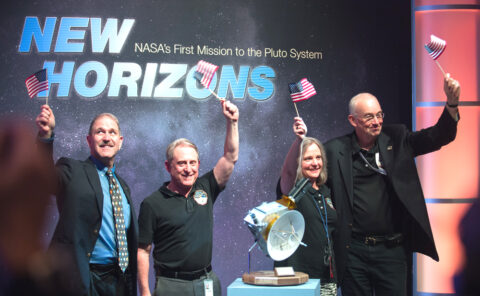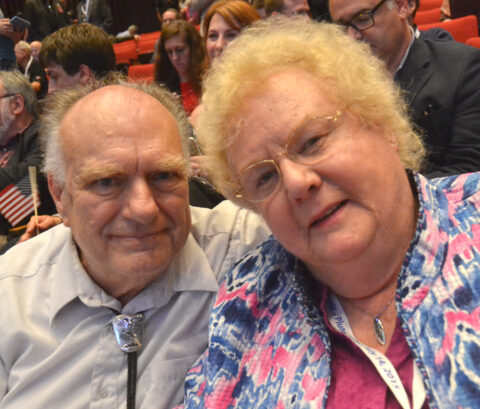After journeying through space for 9.5 years and 3 billion miles, NASA’s New Horizons spacecraft whizzed by Pluto and the Pluto system yesterday, with about a 7750-mile gap between it and the dwarf planet at the closest approach.
“We have a healthy spacecraft, we have recorded data of the Pluto system, and we are outbound from Pluto.”
“We are in lock with telemetry with the spacecraft,” New Horizons Mission Operations Manager Alice Bowman of the Johns Hopkins University Applied Physics Laboratory (APL) in Laurel, Md., announced from mission control, following a message from the spacecraft at 8:52 p.m. Eastern Daylight Time (EDT).
New Horizons actually had its closest encounter with Pluto at 7:50 a.m. EDT that morning, but there was a time delay in receiving signals from the spacecraft because the probe is so far from Earth. “We have a healthy spacecraft, we have recorded data of the Pluto system, and we are outbound from Pluto,” Bowman said.
All “Planets” Now Visited

With this success, the United States has visited “every single planet” in our solar system, said NASA Administrator Charles Bolden, downplaying the fact that in 2006 the International Astronomical Union demoted Pluto to a dwarf planet. “New Horizons has succeeded at completing the capstone event to the historic first era of planetary reconnaissance, a half-century-long endeavor that will forever be a legacy of our time,” he added.
Mark Holdridge, APL encounter mission manager, commented, “How often do we unlock the secrets of a new world? We did that today. How cool is that?”
Science Data to Follow Today
Although the “handshake” received from New Horizons provided a health check and engineering data, by design, it did not send back any new science data yesterday. That will be coming as early as today, according to New Horizons Principal Investigator Alan Stern, of Southwest Research Institute in Boulder, Colo. He likened the forthcoming science data to a deluge of welcome gifts. “For the science team, now it just starts to rain presents every single day for 16 months,” he told Eos.
The New Horizons spacecraft carries spectrometers, cameras, and other science instruments that enable it to make various observations, including examinations of atmospheric structure and surface thermal properties as well as measurements of Pluto’s mass and the masses of nearby particles of space dust.
Discoverers or Their Families on Hand

Among those at APL for the flyby confirmation was James Christy, who discovered Pluto’s moon Charon in 1978. Christy told Eos that he was amazed to see early images of the moon from New Horizons and the distinctions between it and Pluto.
He named the moon for his wife, Charlene, who sat smiling beside him at APL Tuesday. “A lot of husbands promise their wives a moon, but he delivered,” she told Eos.
Annette Tombaugh, daughter of Pluto discoverer Clyde Tombaugh, told Eos that the New Horizons mission is very personal. She said that some of her father’s ashes are embedded in resin on the spacecraft. “In a vicarious way, he got to go to his planet that he discovered.”
—Randy Showstack, Staff Writer
Citation: Showstack, R. (2015), Long-traveled spacecraft buzzes Pluto in close flyby, Eos, 96, doi:10.1029/2015EO032853. Published on 15 July 2015.
Text © 2015. The authors. CC BY-NC 3.0
Except where otherwise noted, images are subject to copyright. Any reuse without express permission from the copyright owner is prohibited.

